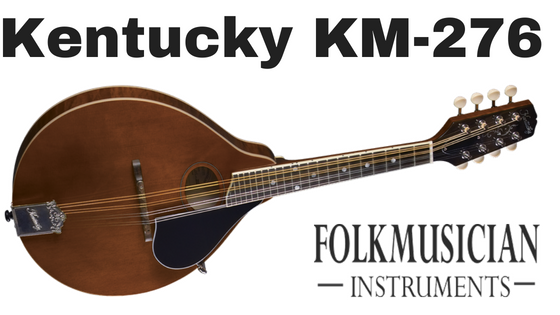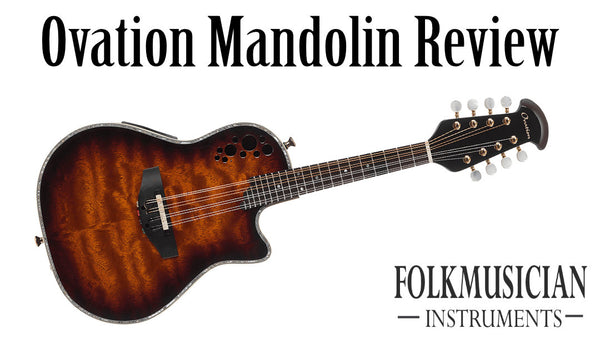The Loar LM-600 vs LM-700 Mandolin

What is the difference between The Loar LM-600 and LM-700 Mandolins?
At first glance, the LM-600 and LM-700 mandolins look nearly identical with the exception of the inlay and gold vs. nickel hardware. There are important differences in construction as well, that result in each having a unique tone.
Cosmetic Appointments
Back to the cosmetics. Both are F-style mandolins and finished identically.
LM-700-VS
The Loar LM-700-VS has the classic Fern inlay pattern that most makers reserve for their highest models. In this case the LM-700-VS is the top mandolin in the lineup, so the fern Inlay is fitting.
LM-600-VS
The Loar LM-600-VS Mandolin has a unique take on the flowerpot inlay. Early versions had a more traditional flower pot design, while the latest versions have a new Greg Rich designed inlay.
Both models share the same hardware that consists of stamped two piece tailpieces with Gotoh Tuners. The only difference is the finish. The LM-600 uses nickel, while the LM-700, features gold hardware for a little more flash.
Differences in looks of the two mandolins
The last cosmetic difference is the grades of wood used. Both have flamed maple back, sides and neck, with the LM-700's woods exhibiting more figuring. They both have solid spruce tops and again, the 700 gets AAA grade. Not to say that the LM-600 does not use good quality woods. They are just not as high of grade cosmetically.
Just based on looks, those are the only differences between the two models. The LM-700 is easy to distinguish by the Gold and fern inlay.
Construction
Are the LM-600 and LM-700 mandolins the same part from the look? No, there are some significant differences in the way these two mandolins are made. At least, this is true of the bodies.
The Loar Mandolin Necks
The necks on the two mandolins are actually the same. They do differ from the lower models though. Both have a nice "V" profile, dovetail neck joints at the 15th fret, extended ebony fingerboards and large (for a mandolin) fret wire. Both necks have bound fingerboards and the headstocks are also bound.
Adjustable truss rod
Actually two way adjustable or dual adjusting truss rods. Both these mandolins have dual action truss rods, which means you can take bow out, or if needed, add bow to a neck. The Loar Mandolin necks have consistently been the straightest of any we deal with near the price point, but it is still nice to have the dual action rod to compensate for changes over the years.
Fingerboard Radius:
These mandolins have flat fingerboards, but wait, that is not 100% correct. While we would call these flat, there actually is a slight radius to them. They are not perfectly flat.
LM-600 and LM-700 nut width
These have 1-1/8 inch nut width and good string spacing. The nuts are bone.
I read that the neck is too large, is this true?
When these models first came out, the necks were larger than normal for an F-style mandolin. This is referring to the girth, not the nut width. Over the years they have been slimmed down, and are more inline with other mandolins. The necks are still slightly larger than Eastman's and Kentucky Master models. The slimming started around 5 years ago. Anything in the last couple of years will have the latest neck.
Gotoh Mandolin tuners
These are a higher model of Gotoh mandolin tuners and work great! There is not much else to say about them. Both models use the same tuners with the exception of the plating (nickel vs. gold).
Ebony Bridge
Both share identical ebony bridges. The only change here is the color of the thumbwheels.
The Body
Here is where things start to get interesting. If you have researched these much, you may have already heard that the LM-700 doesn't have tone bars. Let's start there.
Tone Bars
The Loar LM-600-VS has parallel tone bars. This is the more popular style of mandolin building and what you will find on the vast majority of F-style mandolins. The LM-700-VS does not have tone bars. While this is not unheard of, it is not common either.
What do tone bars do? Here is some misconception that tones bars are needed as bracing. While tones bard do add some structure to a top, that is not the main purpose, hence the name "tone bars". By adding the tone bars to the underside of the top, it tightens things up and emphasis the mid range.
Without the tone bars, the LM-700 has a more open voice. There is also more sustain. In other words, the tone is fuller.
With the LM-600 vs the LM-700, the 600 is a bit more punchy and percussive, where the 700 is fuller and rings out more.
There is more at work here than just the tone bars. As stated, the tone-bars are not specifically meant to be braces, but they do act as such. With this is mind, the LM-700 is carved with a different arch and graduation pattern that the LM-600. This is not readily apparent when looking at the two, but if you ever try to swap bridges, you see just how different things are with the way the feet match the tops. Each top will have some slight variations and bridges can't be swapped between two mandolins of the same model without refitting, they will however be fairly close between two LM-700-VS mandolins as they would between two LM-600-VS mandolins, But take the bridge from the 600 and place it on the top of the 700, and there will be a much larger variation.
So the LM-700 has been designed to not need the tone bars, where the 600 is carved to benefit from them. This is the single biggest difference between the two models.
How do they sound?
We touched on this when discussing the construction. The two models do sound different. It is not just a case of one sounding better than the other. It is worth noting, that most players do prefer the tone of The Loar LM-700-VS. From my experience, somewhere around 80% of people that have tried both, like the 700 best. The other 20% prefer the 600. So we have a majority, but it is not clear that 100% of players would prefer the LM-700.
Is the LM-700-VS worth the extra money?
Good question! Is the LM-700-VS better than the LM-600, and is it worth paying more? Despite it costing more, most players are going to be happier with the LM-700. If you are debating which one to get and don't have the opportunity to try them both back to back, I would say the LM-700-VS would be my recommendation. If the 700 is stretching the budget, or you have a preference for a tighter sounding mandolin, you wouldn't go wrong with the 600.
Although there are differences in the tone, it is not a night and day thing. You notice it, but either of these would be just fine for the vast majority of music genres.
Whichever you decide on, enjoy your new The Loar Mandolin. They only get better with age and play time! You can view the models here: The Loar Mandolins
Leave a comment
Comments will be approved before showing up.
Also in mandolin

Kentucky KM-276 Oval Hole Mandolin
Best Mandolin Pickup K&K vs Radius vs Fishman

